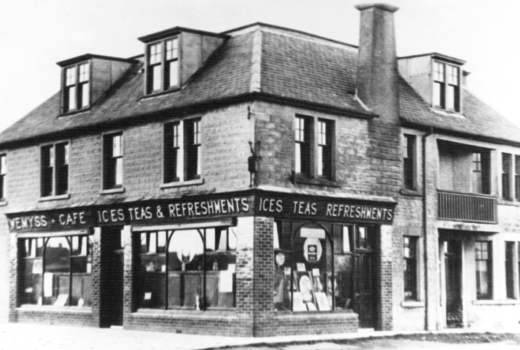Economy | Tourism | Industry | Fishing
Tourism
The burgh’s key tourist attractions were, from the 1930s to the middle of the 1980s, the Pond and the Pond Hall and, from the mid 1970s the Seton Sands Holiday Park, although many visitors had enjoyed Bruce’s Camps in the early years as well.
From its opening in 1932, the attractions of the open-air swimming pool combined with the scenic seaside location to bring holidaymakers and day-trippers pouring in from the Borders, Fife, and the west. During the Glasgow and Paisley fortnights, the burgh became particularly popular, as did the Holiday Camp at Seton Dene – later to become known as ‘Bruce’s Camps.
In the early days, the focus for the holidaymakers was the Pond with, in addition to swimming, entertainment. This was provided by both the local swimming club’s events, and the international swimming galas with many Scottish native and all-comers records established. Pete Des Jardin, the 1935 World Diving Champion was one of the many famous visitors to give displays.
The number of holidaymakers was soon averaging 7,000 a year – two and a half times the population. Established businesses flourished and new shops and cafes opened up bringing much needed employment to the local community. By the end of the 1930s, Cockenzie & Port Seton was firmly established as one of the major seaside holiday resorts on the east coast and the Pond and Pond Hall one of the premier attractions and landmarks contributing greatly to the tourism industry in East Lothian. Post-1945, holidaymakers and visitors flowed into Cockenzie and Port Seton in greater numbers than ever, anxious to enjoy themselves after the severe restrictions of wartime.
The Seton Sands Holiday Camp or Bruce’s Camps is situated on the East Lothian coast road between Port Seton and Longniddry. The camp was started quite by accident in 1924 when some Boys’ Brigade lads asked farmer, William Bruce Senior, who owned Seton Mains, permission to pitch their tents for the weekend. Soon others applied, and as this part was sandy scrubland and no use for agriculture, 52 acres were cleared, and more tents, caravans, huts, converted bus bodies, tramcars and railway carriages were added. Mr Bruce’s son, William Junior, was put in charge. The county council applied strict regulations.
Wartime brought rationing, blackouts, concrete blocks, poles on the beach, and barriers at both ends of the Camp Road where travel permits had to be shown. Only those who were ratepayers were allowed to stay, and only if their wives agreed to help on the land and the children went to local schools. Two holes of Port Seton golf course and the camp tennis courts were ploughed for crops, and sheep grazed on the recreation squares in winter. Camp occupancy dropped by 30%. After the war, some huts and caravans were in a poor state, building materials were scarce but repairs had to be done. The church and amusement marquees were replaced by large huts.
During the 1950s, there was more prosperity. Static caravans were properly fitted out. The council insisted on caravans instead of tents and these now totalled 800.
The Council’s County Development Plan stated:
The camp at Port Seton fulfils a valuable regional need. Such huts are the poor man’s equivalent of the weekend cottage, and are appearing around all big cities. … The two faults of Seton camp are first that it is overcrowded, and second its poor landscaping. Planning permission should not be granted to the erection of any more huts than already have planning permission, and when the temporary permissions expire in September 1951, they should not be renewed. (E.L.C.C. Development Plan, 1950, p8, paragraph 40)
William Senior died in 1951 aged 79. Meantime, William Junior became ill in 1953 and his daughter Margaret helped him to run the camp; he died in 1957 aged 55. His son Bill, a civil engineer, had just been demobbed from the RAF, and he joined Margaret. He organised the campsite and labourers, and she attended to the shop and staff. William Senior’s third son, Craig, was caretaker and lived on the premises. Local joiners built 30 new chalets at the east end and a launderette with six machines; 85 hard standings were laid for caravans, and new toilet blocks, water mains, drains and electricity added
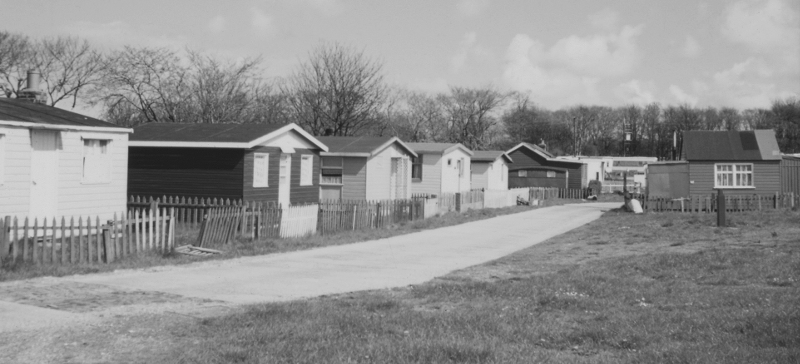
Old chalets at Seton Sands Holiday Camp
By the 1960s, clearance work of 300 sub-standard huts and tram bodies was soon in hand over the winter. The owners of Cockenzie Power Station were looking for accommodation for construction workers; the council suggested making a site at the east end of the camp for 72 large residential caravans, so new roads, car parks and storage sheds were made. Seton Mains was sold in 1966, but Margaret and Bill kept the camp. Bill built three Canadian cedar chalets too.
During the next decade, more of the sub-standard huts were replaced by caravans – the huts had no electricity. A third of the owners bought new caravans with all modern conveniences. In 1973, the camp was sold. The new buyer then re-sold it to Bourne Leisure, so ending ‘Bruce’s Camps’.
Bourne Leisure bought Seton Sands Holiday Camp in 1974. Impressed with the scenic bay location and an established reputation, they invested heavily, improving facilities and upgrading the holiday camp. It soon became one of their top holiday camps in Britain. New buildings included new shops and a terrace bar, indoor heated pool and entertainment complex. The entrance to the holiday camp has also been much improved.
In 1994, the year the Pond closed, Bourne Leisure recorded 30,000 visitors with an average of 2,500 per week over the July and August period. The ratio of holidaymakers to residents in Cockenzie & Port Seton increased from 2.8 in the 1930s to 6.8 in 1994. The increase from 7,000 visitors in the 1930s to 30,000 in 1994 was 430%. By 1995 there were 601 caravan owners.
Unfortunately, from about 1985 on, the attractions of the Pond and Pond Hall were no longer what visitors sought. In addition, by the 1990s, the East Lothian District Council felt that Cockenzie & Port Seton no longer qualified to be considered a tourist resort. By this point the burgh had only two hotels and limited numbers of bed & breakfast accommodation on offer.
Industry
The boatbuilding and repair yard at Cockenzie harbour was owned by William Weatherhead & Sons. William Weatherhead had moved from Eyemouth in 1880 to Port Seton, and then to Cockenzie in 1899. During world war two, the firm had built motor launches and landing craft for the Admiralty, and cabin cruisers for the War Office. These vessels were often of a prefabricated nature but the orders increased the workforce considerably. In charge were Alexander Weatherhead and his son Bill.
In 1946 Weatherheads expanded by taking over the original Weatherhead yard at Eyemouth, and continued to build fishing boats there. In 1950 they re-opened the disused boatbuilding yard at Berwick-upon-Tweed. Meanwhile, at Cockenzie they took over the old salt works site between west harbour and the boat shore in 1949, and within two years had erected offices and warehouses there. The firm continued to build fishing boats, the Star of Hope being built for Adam Jarron, who carried the first Seton Queen on her in 1949. Expertise in the construction of yachts also bore fruition although the Sheherazade proved to be a costly experience. A new venture was the building of lifeboats.
By early 1953, the firm was employing more than 140 men at its three yards, but had overstretched itself, and within a few months cash flow problems led to cutting back. The Berwick yard was taken over by the Fairmile Construction Company, and the Eyemouth yard was sold off. The Cockenzie business, employing about 60, was taken over by J. Samuel White of Cowes, Isle of Wight, to become William Weatherhead & Sons (1954) Ltd. Most of the employees were retained and business carried on very much as usual. Orders from official sources were still important. Between 1953 and 1955 three minesweepers were built for the Admiralty. H.M.S. Egeria, an inshore survey vessel, was launched for the Navy in 1958. And in 1959 an order for launches for Trinity House was received.
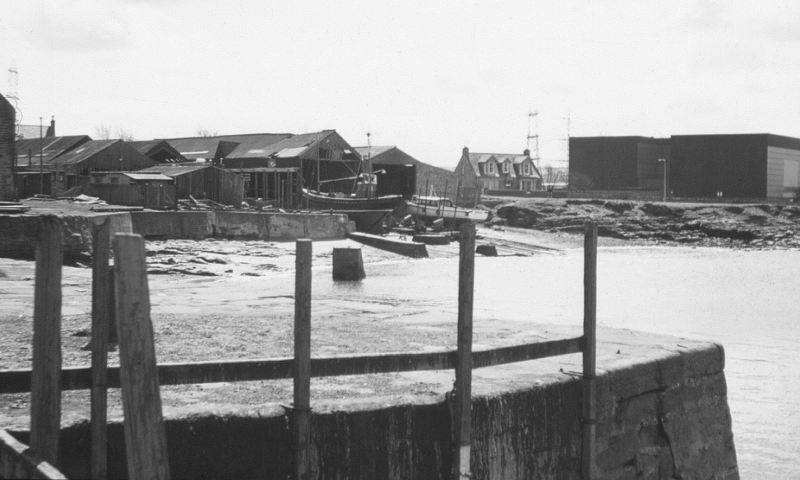
Cockenzie harbour and boatyard
Yacht and fishing boat construction continued. The pleasure yacht Venetia was launched in 1959, and a year later the seine netter Scarlet Cord II was built for George Buchanan. There were also orders for motor cruisers. Forty special lifeboats, of an innovative design, were built for the Russian trawler fleet during 1955 and 1956. Over the years further orders were received for lifeboats, their hulls being made of wood, aluminium, or fibreglass. The firm also carried out repair work for the R.N.L.I. Tragically the Broughty Ferry lifeboat Mona, whose crew had been lost trying to aid the North Carr lightship, was brought to the yard in December 1959, and later secretly burnt.
Weatherheads had a reasonable profile and exhibited at the Boat Shows in London throughout the 1950s, and later in Glasgow. Yet, in a very competitive market, the firm found it difficult to survive. It carried a large office staff, especially draughtsmen. A change of name to J. Samuel White (Scotland) Ltd. in 1965 signalled closer control from the Isle of Wight, but to no avail, and the yard closed in 1969.
The yard at Cockenzie harbour was taken over by Cockenzie Slip and Boatyard Ltd. run by Henry Macnamara and his two sons. Mr Macnamara had come to Weatherheads as yard manager in 1940 to supervise the construction of craft built for the war. He stayed on afterwards, and into the J. Samuel White era. The Macnamaras had no need of extensive offices and so the old saltworks site was sold off. The MacNamaras mainly carried out repair work, but they did build some new vessels. Although not for the local fleet, they built the occasional fishing boat, usually of larch or mahogany. They also built yachts, and carried out conversions to yachts, such as that of the fishing boat Jesmond.
An important commission led to the launching of a three-quarter sized replica of the Charlotte Dundas on 4 November 1988. The Charlotte Dundas is reputed to have been the world’s first steamship. Built by William Symington, it was demonstrated on the Forth and Clyde Canal in 1803. The replica was built for Falkirk District Council.
With a recession in boatbuilding, Cockenzie Slip and Boatyard Ltd. was put into liquidation. The liquidators sold the yard to Alex McCran, a joiner, in 1996. At present (2002) Mr McCran’s firm Coastcraft Ltd. builds and repairs boats, and also does shopfitting. They build small yachts in timber and fibreglass, and repair fishing boats and yachts, and pilot boats for the Forth Ports Authority.
Weatherhead and Blackie was started at Port Seton harbour in 1958 by Bill Weatherhead and John Blackie. As a direct result of the problems encountered by the original Weatherhead business these former employees started out on their own, building ring-net fishing boats for owners on the Ayrshire coast, as well as seine netters for the home fleet. The 70-foot dual purpose Jesmond was built in 1959 for Robert Home, and the Ebenezer (Peter Ross), Olive Branch (Tom Little and King Donaldson), and Freedom II (D. Johnstone) were all built in 1960. There was also the odd motor cruiser built.
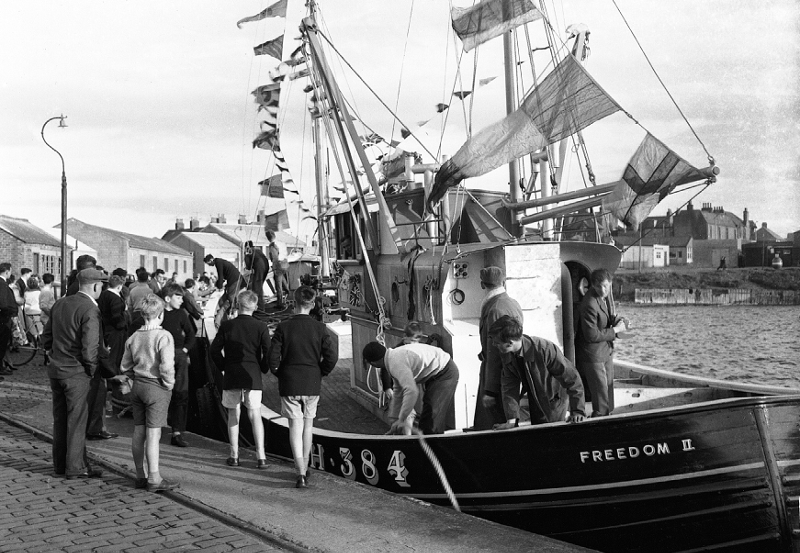
The fishing boat ‘Freedom II’ was built in 1960 by Weatherhead and Blackie (A&J Gordon)
The yard at Port Seton was uncovered, and feelers were put out in 1961 about obtaining more suitable premises at Dunbar. The Port Seton yard closed in 1965 and the business moved in the following year to Dunbar where it operated until 1976.
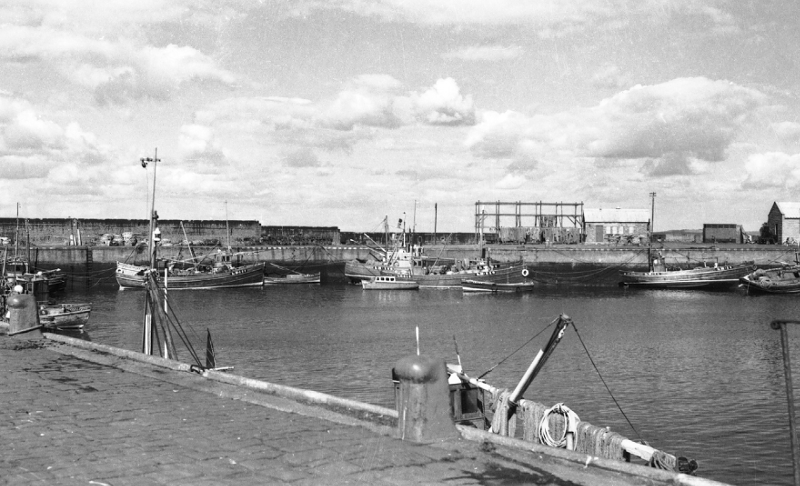
Port Seton harbour with net-drying shed on the far side and net mending shed on right (A&J Gordon)
Fishing
This account of the fishing industry from a Port Seton and Cockenzie angle comes from the well-known and respected fisherman, Billy Thomson (Bumps), who first went to sea in 1963, aged 13, and is one of the few locals still earning their living at ‘the fishing’.
Billy first went to sea when John Johnston (Jock Toosh), skipper of the Girl Ann, broke his leg playing football. Billy was roped in as an extra pair of hands to work on the boat during the school summer holidays. He brought home between £6-£9 per week, more than his miner father earned at the pit face of Prestongrange colliery. At the age of 22, Billy became skipper of his first boat, the Rosehaugh.
Sea fishing out of Port Seton reached its peak in the 1970s. There were as many as 240 men employed locally on the 50 boats operating out of the harbour. The biggest boats – between 50′-70′ in size – carried crews of six to seven men with the smaller boats carrying two to three men. The boats fished all over the North Sea, with bigger boats going out for a week at a time for catches of white fish. Smaller boats took on prawns as well as fish. Catches were landed at Eyemouth in winter and North Shields in summer. The Port Seton boats would radio the size of their catch to Tommy Johnston, who would then place the expensive link call into the coastal station where the catches were to be landed, to ensure sufficient lorries were waiting to take the fish to market. In one week’s fishing in 1979, one boat, the Girl Janice, landed 400 boxes of cod out of the Forth, grossing £5,000.
The money would be divided as such – assuming a boat crewed by four men grossed £1000 for a week’s work, £200 would go aside to cover fuel, repairs etc, and the £800 left would be split £400 to the owner (who would pay the skipper an extra £100 from this money) and £400 to the skipper and crew to be shared equally. This is still the method used – and no catch means no pay.
One reason for the boom in sea fishing was technology. Sonar to detect shoals of fish, radar to ensure the skipper knew exactly where the boat was, regular radio contact giving up to date weather reports, all led to an increasingly efficient fishing fleet. However, knowledge of the traditional methods still came in handy. For example, when a row with his partner led to his boat being stripped of crew and equipment, Billy Thomson, assisted only by his wife Janice on a boat normally crewed by five experienced men, used his skill with the ‘meezies’ (landmarks used by fishermen in the pre-technology years) to locate the shoals and land a catch of 16 boxes at Eyemouth – only three boxes less than his well-equipped and over-crewed ex-partner!
In what has become a legend in fishing folklore, a Port Seton boat, in 1975, was found guilty of salmon poaching off the Carr light ship near Montrose. The skipper was fined £2500 for destroying evidence and £50 for abduction of the officials sent to apprehend them! The fine was borne with great dignity, at a time when boats could make £5000 from a good week at poaching!
In 1977-8 a divorce between a Peterhead fisherman and his wife caused repercussions for fishermen all over Scotland, when as part of her settlement she demanded a share of the stoker. The stoker was the name given to monies received for the black market sale to fish and chip shops of codlings – white fish just the right size for frying. This started an investigation by the Inland Revenue and resulted in tax bills between £40K-£200K for many fishermen, including several Port Seton locals.
Local boats have also netted hundreds of wartime mines, but the most notable find was in 1995 when the Girl Janice brought a torpedo up from the seabed three miles off Elie on the Fife coast. When the Royal Navy bomb squad arrived, they could hardly contain their excitement – the torpedo was one of the largest ever manufactured by the Germans during world war two, and contained 1500 pounds of TNT! When it was detonated at around 12.30am, Cockenzie Power Station switchboard was jammed with calls from locals who had been shaken from their beds by the vibrations, and were convinced something had exploded there!
Unusual catches have included bottles of eight-year old Bell’s whisky from around Inchkeith Island in the Forth. Peter Donaldson (Patey Dole), skipper of the Jackie D. landed the first two bottles and made a huge fuss about his luck over the radio to the envy of the other boats! Then Billy Thomson’s boat, the Janreen, landed a bottle, quickly followed by Robert Johnston (Bo-Bo) on the Fruitful Harvest and Andrew Mark on the Arturis. It was reckoned that the whisky was dumped contraband.
Government legislation introduced in 1993 to reduce the British fishing fleet by 33% saw the Port Seton fleet decimated. The decommissioning of fishing boats took place over three phases and the men who once crewed them either retired or moved on to work elsewhere – one took his knowledge of the sea to behind the fish counter at a local supermarket!
At the present time, there are approximately 40 fishermen working out of Port Seton, crewing ten boats, the largest of which is 44 foot. Boats are – Teran, Girl Jean, Vestra, Emma Christie, Morning Star, Montana, Provider, Janreen, Silver Crest and The Maker. Port Seton boats are registered in Leith and have the prefix LH to their registration numbers. The catch is mainly prawns, which are sold in Eyemouth and then exported to France and Spain. The boats still have their whitefish licences, but do not land enough to make it a viable catch. Overfishing, European legislation and an increasing number of seals locally are blamed for the lack of white fish landed. Prawns are caught in the Forth, and some boats will go through the Caledonian Canal to spend a week at ‘the prawns’ on the West Coast. The bigger boats can earn £2000 on a good week.

Fishermen at Port Seton harbour, 1970s.
Port Seton was once a renowned fishing village, but is now little more than a dormitory town for Edinburgh. Most of the local men still fishing would not recommend ‘the fishing’ as a career choice to youngsters today and with such feeling it is almost certain that fishing in Port Seton will not survive until the next Statistical Account.
The fishing communities of the county still use much of their local dialect; Cockenzie & Port Seton is no exception. The rich fund of words and expressions are, however, slowly disappearing, although bynames (nicknames) are still in common use. The following tale is made up of phrases and words writer Annette Gilroy has either overheard or been told about over many years. Like the story, any names are fictitious!
A Meeting of Two Fishermen at the Harbour
Hoo’ did ye git oan? Hoo’ mony boaxes?
No’ mony. An’ it was a’ sma’. An’ durty. A’ durty!
Ah think ah’ll bide till efter the haur afore ah go bauk.
Duv ‘e’ no ken tae dae thaut. Ah thocht ye wid ‘a’ kent thaut.
A weel. Ah’ll bide till it’s time for the prawns. Bowdie says they’ll no’ be lang.
Aye but wha’ aboot Taurley. He’s gaun thi mom.
Guid luck tae ‘im. Ah hope it’s no a waste o’ time an’ diesel – but then, he’s goat plenty o’ baith! Is your wee Boabbie no’ weel? Ah saw yir mither comin’ oot the surgery wi’ ‘im.
He’s been as seek as a dug, an’ they goat that new doactor wha’ said tae ‘im, “PUT OUT YOUR TONGUE, YOUNG MAN”, the daft-like gowk that he is. The bairn didnae ken wha’ he was speirin so ma mither said, “Stick oot yir melt, ma lamb”.
An’ wha’ aboot James. When’s he gaun tae the fushin’ wi’ ye?
Efter the simmer hoalidays. Ma mither saw him wi’ a laussy and said if he’s auld enough for winching, he’s auld enough to work. An’ she telt him what she said to me years ago, to mind wha’ he was aboot and whae he was gaun oot wi’. He’d dae better to find yin o’ oo. There’s to be nae Cautholics and naebody fae Tarnent or the Pauns. Wha’ aboot your Chaurleseenie? Is she no’ lookin’ for a laud?
Gi’e her a chaunce! She’s only ther-teen. It’ll be a while afore she thinks aboot a laud.
That’s no wha’ ah heard. She was no hauf enjoying ‘ersel’ at yin o’ thae discos they have.
That’s as may be but ah leave a’ that tae the wife. An’ Chaurleseenie wid no hauf get lauldy if she’s been blauk-affrontin’ us! Ither laussies can show their fooshin-upness if they like but ah dinnae think she wid.
Did yi see thaut television crew filmin’ doon at the herbour the ither day. At first ah thocht they were daein’ a programme on Goolwau but no, it was a’ aboot Joahn Bellany again, him buyin’ a hoose oot in Italy, in Tuscany. Yin o’ them ausked me if a minded onythin’ aboot the Boax Meetin’ an’ ah telt him o’ the swee boats an’ the chair-o’-planes at the shows, and the banefire that was licht on the Boat Shore.
He wis trying tae git me to auct oot a fush sale. To say a’ shillin, a’ shillin, ochteen pence, ochteen pence. Ah telt him ah couldnae dae it but he recoarded it oanywye and went awa’ beamin’. Aye. It disnae tauk much to keep some folk hauppy!
Annette produced this piece for the Port Seton Writers’ Group.
